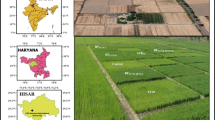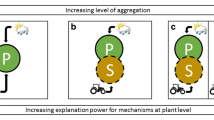Abstract.
Maize and berseem are among the most important crops in India and several other countries in the world. Irrigation is provided to these crops to get higher production; hence, determining the water requirements of these crops is important for irrigation planning. Improved water management of these crops requires accurate scheduling of irrigation, which in turn requires accurate measurement of crop evapotranspiration (ETc). Thus, the first objective of this study was to measure daily, weekly and seasonal ETc of maize and berseem directly from weighing type lysimeters. Experiments were conducted in a set of two electronic weighing-type lysimeters of 7.82 m3 to measure the hourly ETc of maize and berseem from June 1996 to April 1998 at Karnal, India. The average daily ETc of maize varied from <2.8 mm day–1 in the early growing period to >4 mm day–1 at development and reproductive stages. The peak daily ETc of maize was 7.7 mm day–1 and this occurred 9 weeks after sowing (WAS) at the silking stage of maize when leaf area index (LAI) was 5.5. The measured seasonal ETc of maize was 354 mm. In the case of berseem, the average daily ETc was 0.9 mm day–1 at the initial stage, achieved a peak value of 6.9 mm day–1 between 25 and 26 WAS during the fifth cut. The measured seasonal ETc of berseem was 480 mm.
Precise information on the crop coefficient, which is required for regional-scale irrigation planning, is lacking for semi-arid climates such as those found in north India. Therefore, the second objective of this study was to develop crop coefficients (K c) for maize and berseem from ETc measurements and weather data. The estimated values of K c for maize by the Penman–Monteith method at the four crop growth stages; namely, initial, crop development, mid-season and maturity, were 0.55, 1.00, 1.23 and 0.64, respectively, and the corresponding values for berseem were 0.76, 0.82, 1.11 and 1.24, respectively. In the case of these two crops, actual K c values determined from this study are different from those suggested by the FAO (Allen et al. 1998), indicating the need for generating these values at the local/ regional level.
Similar content being viewed by others
Author information
Authors and Affiliations
Additional information
Electronic Publication
Rights and permissions
About this article
Cite this article
Tyagi, N.K., Sharma, D.K. & Luthra, S.K. Determination of evapotranspiration for maize and berseem clover. Irrig Sci 21, 173–181 (2003). https://doi.org/10.1007/s00271-002-0061-3
Received:
Accepted:
Issue Date:
DOI: https://doi.org/10.1007/s00271-002-0061-3




